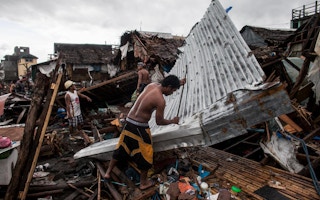Although the Philippines is no stranger to typhoons, it is now no longer deemed unusual for the archipelago to experience the most destructive kind of cyclones, known as “super typhoons”, said environmental watchdog Greenpeace.
To continue reading, subscribe to Eco‑Business.
There's something for everyone. We offer a range of subscription plans.
- Access our stories and receive our Insights Weekly newsletter with the free EB Member plan.
- Unlock unlimited access to our content and archive with EB Circle.
- Publish your content with EB Premium.
Under the revised definition of a super typhoon by the country’s weather bureau, the Philippines experienced seven times more super typhoons in the past six years than previously recorded.
“It’s official—the Philippines is a super typhoon hotspot. Out of the average 20 typhoons we experience every year, as many as six of these can be super typhoons, [making it] our new normal,” said Greenpeace campaigner Virginia Llorin.
The country’s weather bureau originally categorised a super typhoon as having maximum sustained winds exceeding 220 kilometres per hour (km/h).
But based on the new definition announced by the Philippine Atmospheric, Geophysical, and Astronomical Services Administration (PAGASA) last week, tropical cyclones with maximum sustained winds of 185 km/h or above will now be categorised as a super typhoon.
Using the new system, fourteen cyclones will be reclassified as a super typhoon, including last year’s strongest storm, Typhoon Rai, which left 400 people dead and more than US$500,000 worth of damages to crops and houses. Rai was previously not considered a super typhoon under the old definition despite the destruction it caused because it only had maximum sustained winds of 195km/h.
Only two storms from 2016 to 2021 were documented as a super typhoon under the old classification.
The definition of a typhoon was also revised. From the original range of 118 to 220 km/h, a typhoon will now have maximum sustained winds of 118 to 184 km/h.
PAGASA said it made the changes in order to have a more efficient warning system to better prepare disaster managers on the ground.
That super typhoons are no longer considered unusual in the country is just the “tip of the iceberg” as worse scenarios lie ahead without meaningful and urgent climate action, said Llorin.
She cited how the latest report from the Intergovernmental Panel on Climate Change (IPCC) released earlier this month showed how climate risks are appearing faster and will get worse sooner than previously assessed, and that they have been disproportionately affecting people in highly vulnerable geographies.
Impacts on communities that are least responsible for the climate crisis, and least able to cope, are also more severe, the report read. In the Philippines, the climate crisis has been costing communities their lives and livelihoods for decades, causing damages of up to almost US$10 billion over the past 10 years.
“Filipinos are already suffering from climate impacts and it will get worse,” she said. “We need systemic change and justice. The solution is not one-off actions, but bold, visionary, transformative policies that will secure the safety and well-being of Filipinos for decades to come.”

















